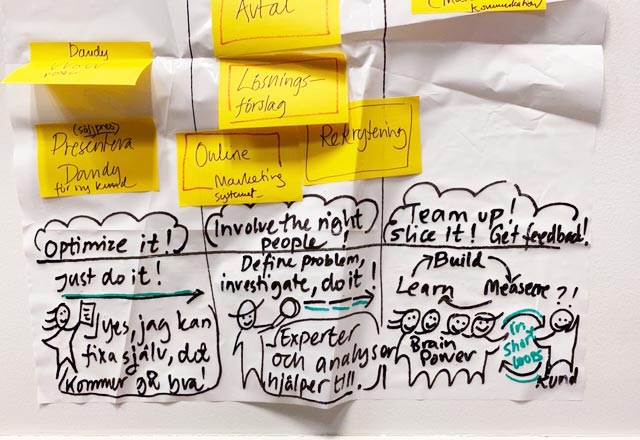Some months ago we had a meeting at Dandy trying to figure out and agree on who should be responsible for what, and how to divide our internal work in a better way. We needed to find a way to scale sustainably and figure out what capabilities we were looking for to expand our team in a good way also for the future.
We started to map the work we do and group it in different ways. But whatever we did we seemed to end up in traditional boxes, “this is marketing stuff, this is sales, this is finance, this is HR”… And then fighting over what the difference was between sales, marketing and finance… Everyone with their own ideas on what was right or wrong. That was of course not what we needed, another silos-based and ineffective organization :o)

Download the Cynefin Decision-Making Board (PDF) >
We then said ok, what about mapping the work we do based on the Cynefin framework? Wouldn’t that be a good way of looking at it instead? We draw the Cynefin sense-making framework with the Obvious, Complicated and Complex domains on the board with one column each and started to put in all our sticky notes with our different activities on them. After just a couple of minutes, we could see that we had solved the puzzle! It was like open sesame to a totally new way of looking at what we do! Finally, we could get a picture that made sense to all of us that we could act on!

Now we use the Cynefin Decision-Making board as a mental model to map out what type of ways of working and decision-making process is needed based on if it falls into the Obvious domain, Complicated domain or the Complex Domain.
For the Obvious domain, it is ok to just do it yourself. In the Complicated domain, we want to work two and two and bring in experts when needed, and for the Complex domain, we collaborate to understand the problem, scope it, prototype and test it. This goes for all our internal processes and management processes (we call it management innovation) as well as for business development of course.
As always, we are so much better together!
If you feel like trying it out you can download it for free and test it with your team or group.
How to facilitate it
- Print out the board and gather the team/group
- What are you working on or making decisions about? Write it down on a sticky note.
- What domain does it fall in? Discuss it within the team/group and agree.
- If it is a high-risk subject, always put it in the Complex domain.
- Act based on the domain. If possible, try to move it towards the left from complex to obvious with for example automation of that process. By doing Scrum and working in two-week sprints you pull yourself from complex to complicated.



Great stuff. Download link is not working though.
Hi Kristian,
Thanks for the feedback, we appreciate it! The link to the file is now updated.
We wish you a happy Monday 🙂
The link to the PDF does not seem to work.
Hi Henric,
Thanks for the feedback, we appreciate it! The link to the file is now updated.
We wish you a happy Monday 🙂
Thank you,very interesting
What is the reasoning behind not talking about chaos?
Thank you
Hi Martin, sorry for the late respons. The purpose of this board is to map out the activities we do, in what domain they are and by that enable us to act on it in the appropriate way. Chaos is not on the board since it is a domain you enter by accident if you use practices from the obvious domain when you are in the complex domain (then you fall over the cliff in the Cynefin visualization) – or in a controlled way, in time-boxed sessions when you are in the complex domain. And if you would be in chaos by accident, you have to react with your backbone reflexes to get out of there. I hope it answers your question?